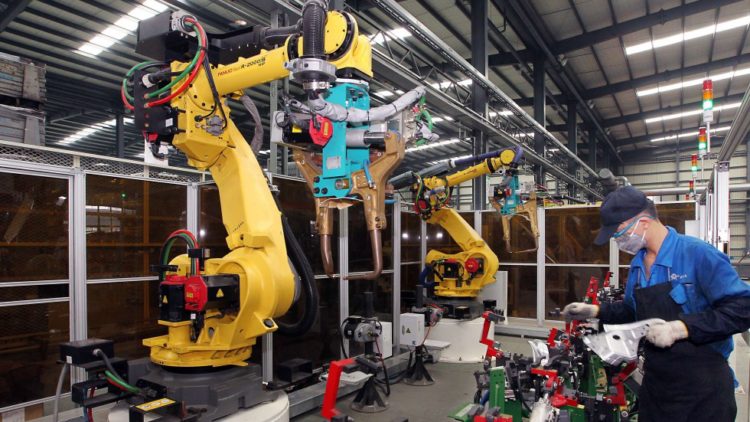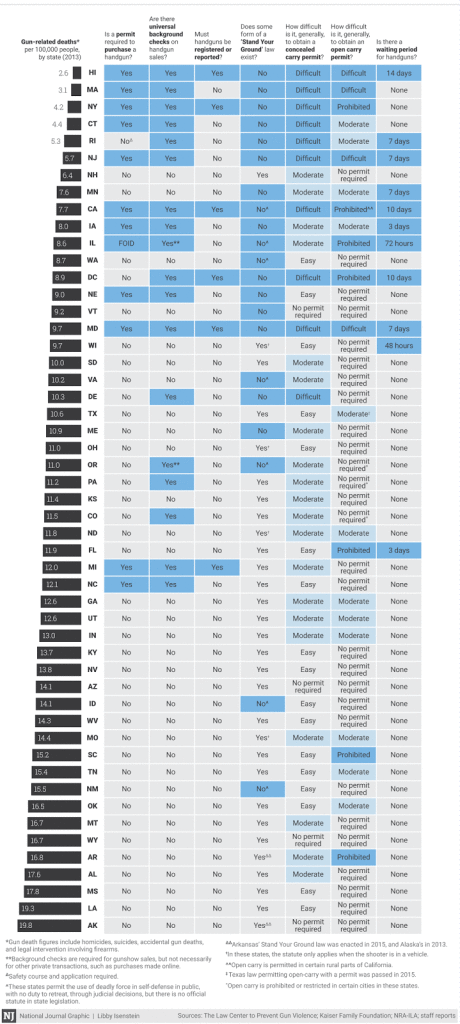Autumnal Urban Foliage
The Oncoming Labor Storm
The rise of ‘right-wing’ politicians in post-industrial countries — politicians such as Donald Trump of the United States of America, Marie Le Pen of France, the late Jörg Haider and his successors in Austria, and others, and similar movements, such as the Tea Party movement in the U.S. — are only the beginning of what will probably be a 20 to 50 years of reactionary protests as major countries (indeed, all countries eventually) now transition from the Industrial Era into the Informational Era. The 2020’s will likely be a particularly tumultuous decade.
The Informational Era denotes a period in human history when most economies are based upon performing services rather than manufacturing products. The U.S. have now entered that period and become ‘post-industrial’. Part of that transition has involved low-skilled manufacturing and industrial jobs (such as manufacturing thread or clothing, electronic devices, or simple furnitures and supplies) migrating to other countries where lower wages are paid. That part of the transition has been occuring during the past 40 to 50 years. However, another major and often overlooked part of this transition from Industrial to Informational involves robotics. For examples, very many manufacturing jobs in the U.S. have been replaced by robotics. An industrial robot controlled by someone who has a master’s degree in engineering can replace anywhere from several to a dozen or more manual laborers. These machines pay for themselves in only a few years. This revolution in robotic has transformed manufacturing in many countries. Hundreds of thousands, perhaps more than a million, industrial jobs in the U.S. have been lost due to robotics replacing workers, yet industrial manufacturing output in the U.S. has risen to record levels, exceeding output during the Industrial Era. Another reason why this new era is being called Informational is that technology has developed machines that can now use information (i.e, their programming) to create actual products in ways light years beyond what the simple Industrial Era mechanical loom could do.
Moreover, that robotics revolution has begun to invade those countries were industrial jobs have migrated due to low wages. Earlier this year, the South China Morning Post of Hong Kong reported that one factory in China’s Jiangsu province used robots to replace 60,000 workers, and that 600 other companies in that province were drafting similar restructuring plans. In Taiwan, Foxconn, which manufacturers computer products for Apple, has spent a total of $500 million on robotics, likewise replacing 60,000 employees with robots. As the pace of technology makes these manufacturing robots more advanced and less expensive, this robotics revolution will continue.
Right-wing politicians in post-industrial countries make the false claim that they can restore manufacturing jobs in their countries. Their claims are false because no employer will willingly rehired industrial workers when robotic equipment can manufacturer the same goods better for less costs. Nevertheless, these false claims by right-wing politicians fan the hopes of now unemployed industrial workers who yearn for the way things used to be, notably their former paychecks.
So, what happens in the world’s countries once more and more industrial workers are unemployed by robotics? For instance, what happens once 50 million to 100 milion Chinese workers become unemployed due to robotics? Will the Chinese Communist Party be able to continue its control over that many sidelined workers? How much more seductive will the right-wing’s continued false promises of a return to full industrial employment in Western countries be?
The Massachusetts Institute of Technology’s Technology Review examined these issues earlier this year in a series of essays whch are worth reading. The transition from the Agricultural Era into the Industrial Era 250 to 150 years ago (date depending upon country) caused massive societal, civic, political, and labor problems. We’ve again are in such a transition.
Although I won’t belabor you with it, I was recently reading an essay in the London Review of Books in which the term ‘post-capitalist’ society was used. It was remarkable because it didn’t use that term in a a Marxist sense, as it might have been used in the 20th Century. It instead used the term ‘post-capitalist’ to mean post-industrial societies in which the employment problems of this epochal transtion from Industrial Era to Informational Era have been solved. Under pure capitalism, it is unlikely that factory owners will want to pay for retraining the workers who the introduction of robotics has unemployed. Yet no efficient society can nominally have huge numbers of unemployed people or, better put, unpaid people. How nations deal with this transition will be one of the major challenges of the 21st Century.
25 July 2016
Late July and early August are slow times for me. My consulting practices slows down as clients in the northern hemisphere go on holiday plus I’m on summer holiday from teaching my New Media Business course at Syracuse University’s graduate school (although I annually during August update its eight-year old syllabus for the latest changes and developments in media business). So, in my spare time, I’m doing cooking and drinking (no, not that type of drinking!)
I mention new media, which is all technology-based, and cooking because even the later subject is being changed by technology. I’m not talking about molecular cooking or other esoteric cuisines, but about even such things as simple as outdoor grilling. Consider the robotic BratWurst Bot, presented at the Stallwächter Party 2016 summer political festival in Berlin where it perfectly cooked more than 200 sausages autonomously. People grilling meats outdoors is neolithic, which you might says means somewhat traditional. On a nice, sunny, summer day, however, I wouldn’t mind having one of these contraption—provided it came with an option that also automatically serves German beers!
While on the subject of drinking, the BBC has collected nine famous drinking quotes from Ernest Hemingway.
Beans, I say. This past weekend, The New York Times published an excellent guide to cooking beans.
By the way, if you get a chance, check out how Humanitas, a retirement home in Deventer, the Netherlands, provides the elderly with the care and social interaction that they need to remain physically and psychologically healthy, by providing free lodging in the retirement home for six students who spend at least 30 hours a month with the 160 elderly residents living there, helping the elderly whether prepare their meals, shopping with them, or teaching them to use computers or even paint street art! Great video about it at this website.
Am listening today, via YouTube, to ElectroHouseBangers‘
#
Bucolic Connecticut
My native state of Connecticut lacks high mountains and grand canyons, but its scenic wealth is its lush and gently rolling forests and small farms. That is what attracted most of the American Impressionist landscape painters to it a century ago. The tiny state has been one national park, the Weir Farm National Historic Site in the town of Wilton. It’s the 60-acre former home of artist J. Alden Weir (1852-1919), formerly of New York City, who owned homes here and 90 miles (145 km) east across Connecticut in my native town of Windham. Other late 19th Century and early 20th Century American Impressionists, such as Childe Hassam, Albert Pinkham Ryder, John Singer Sargent, and John Twachtman, also visited Weir and painted here. Weir’s landscapes hang in the Metropolitan Museum of Art in New York City, the Smithsonian Institution in Washington, D.C., and many other museums. My sister-in-law and I’m are fortunate to have inherited two Weir landscapes, one of which the artist apparently gave to my great-grandfather a century ago. Earlier this month while visiting Weir Farm, about 45 minutes from where I now live in Connecticut, I decided to ‘channel’ Weir’s vision through my digital single-lense reflex camera.
Excellent, Computerized-Video Recreation of 24 August, Year 79, in Pompeii
From an exhibition at the Melbourne Museum in Australia.
Where The Sun Doesn’t Rise In The East Nor Set In the West
Propagandists frequently fool people by focusing them on a point of data that doesn’t represent the whole of the data and claiming that this exceptional point of represent the whole of the data.
The graphic at left is an example. The graphic states that the state of Vermont, which does not require the licensing of its citizens’ firearms, has the third-lowest crime rate in the United States.
That statement is largely true: Vermont does not require the licensing of its citizen’s firearms. And Vermont has a low crime rate compared to the other 49 U.S. states (for example, it had the 15th lowest gun homicide rate during 2013).
The graphic attempts to convince people that not requiring permits or licenses to own firearms—in other words, looser laws about gun control—results in fewer crimes. It infers that looser gun laws anywhere equal less crimes of any kind.
The rural state of Vermont (largest city: 42,417 people; second largest city: 17,904 people) does indeed have a low crime rate. However, the whole data about crime in the U.S.—in other words, the data for all 50 U.S. states—shows the opposite correlation between gun laws and crime. That data shows that Vermont is a rare exception to what’s overall true.
The table below list each U.S. state, it’s rate of gun-related deaths, and how strict (blue) or loose (grey) its gun laws are. This overall data shows a direct correlation—more strict gun control laws equal less gun-related deaths and safer citizens. (For another example of such overall data, see Harvard University’s conclusions about multiple scientific studies by it and other universities that study public health and crime—neutral studies that weren’t funded by either the gun lobby or by anti-gun advocates.)
It’s easy for propagandists to cherry-pick an outlying data point—something that is actually an exception to the overall rule (such the low crime rate in Vermont, an exceptionally rural and sparsely populated state)—from which they will then attempt to infer a false conclusion. Such propaganda will probably fool people who don’t think to look at the overall data or who simply want the false overall conclusion to be true.
Such exceptions can be found in almost any set of data, even data in which most people would never expect there to be any exceptions. For example, everyone knows and understands that the sun rises in the east and sets in the west. However, there are actually two places on Earth where that is not true (see beneath the table below for the answers where). Yet does the existence of those two exceptional places mean that people can’t rely on the sun rising in the east and setting in the west? Of course not. Don’t be fooled by propagandists cherry-picking data.
By the way, where are the two places on Earth where the sun doesn’t rise in the east nor set in the west? The North Pole (where the sun is always exactly south, rising due south and setting due south) and the South Pole (where the sun is always exactly north, rising due north and setting due the north).
Married Three Years!
I yesterday began my fourth year of being married to this beautiful Spaniard. Brains (‘Doctor Professor’ is how European academics address her); beauty (well, just look at her picture!); a marvelous personality (no wonder that some folks know me as ‘Mr. Rodriguez’); and the patience required to live with me (no explanation necessary). I love her dearly. Happy Third Anniversary, Emma!
In the Mood Today for East Asia
I’m in an eastern Asian mood today. Many things have reminded me of it.
For instance, Thailand is renown for its Public Services advertisements on television. Here is a recent example, a full movie told in only three minutes:
Click here to read Adweek’s story about why and how it was produced. The same producers two years earlier created a possibly even better Public Services short, about compassion:
The story behind that one is here.
∅

Kudos to Chinese pharmaceuticals billionaire Li Jinyuan who took 6,400 of his employees on a nine-day vacation in France. They arrived aboard 84 commercial flights and occupied 140 hotels. the cost was €15 million ($18 million).
∅
Who exactly won? Forty years after Communist North Vietnam took over capitalist South Vietnam, an international poll reports that Vietnam is now the world’s most capitalist country. China was ranked fourth.
∅
When traveling to such places, or anywhere in the world, I’d always thought that the best passport to have was Swiss, because nobody blocks the politically neutral Swiss. However, CNN reports that the best passport to have is actually U.S. or U.K., followed by France, South Korea, or Germany, or Sweden, or Italy, or Denmark, Singapore, Finland, Japan, Luxembourg, or Netherlands, and only then Swiss. Those groupings are based upon how many countries the passport holder is allowed to enter either without a visa or by relatively easily obtaining a visa upon arrival at the border. One hundred forty-seven countries permit that for U.S. or U.K. passport holders.
∅
Speaking of travel, it was interesting to see the the CEO of the Starwood Hotel Group concede that his company’s Sheraton brand has become tired and in need of change.
∅
You might say that I’m sensitive to submarines. Although my naval officer father served aboard surface ships during World War II and the Korean Conflict, I grew up around New London, Connecticut, headquarters of the U.S. Navy’s submarine fleet. Seeing nuclear submarines silently leave that port (which was actually across the river in the town of Groton) was a routine sight. By far the most advanced submarines in the world are the Seawolf-class submarines constructed just after the end of the Cold War. These ships indeed are parts of a trio of U.S. ‘superweapons’ that no other nation possess. The other two in the trio are the super-accurate LGM-30G Minuteman III missiles (each capable of delivering within 30-minutes a thermonuclear warhead, with 20-times the explosive power of the Hiroshima explosion, within 200 meters of any target on Earth) and the super-stealthy F-22 Raptor fighter/bomber aircraft (which virtually can’t be detected by enemy radar and cruise without effort at supersonic speeds). There are only three Seawolf submarines – SSN Seawolf, SSN Connecticut, and SSS Jimmy Carter – because of the extraordinary cost of building each. The Seawolfs were designed to beat the Soviet nuclear nuclear submarine fleet in the event of war, but cost of $3 billion each ($3.5 billion for SSN Jimmy Carter), so, no further Seawolfs were constructed once the Cold War ended. Like F-22, the Seawolfs are super-stealthy, almost undetectable underwater by an enemy ship or submarine. The reason why the USN Jimmy Carter was even more expensive was that it was modified to be totally a spy submarine. What really interested me was why ten years ago the U.S. Navy decided to transfer all three Seawolfs from New London to that navy’s Pacific Ocean submarine base in Bremerton, Washington. It’s true that the Russian Navy is no longer as formidable as it was during the Cold War, but it still has missile submarines at undersea. My guess is that the U.S. Navy viewed the rising Chinese Navy as the future threat, so it moved all three Seawolfs to the Pacific. However, an article in Medium.com notes that the three Seawolfs have recently been further modified for operations under the Arctic Ocean where many of the Russian Navy’s missile submarines still lurk. Geopolitics is truly pivoting to Asia’s eastern and even northern boundaries.
Meet Ahmet Merabet, The Muslim French Policeman Who Gave His Life Defending Freedom of Speech
Meet 49-year old Ahmet Merabet, a Muslim policeman from the 11th Arrondissement of Paris, who on Wednesday (7 January 2015) gave his life defending the right of free speech. He and 49-year-old policemen Franck Brinsolaro, a French Christian, where guarding the offices of the satirical weekly newspaper Charlie Hebdo when three Islamicist terrorists attacked with assault weapons, killing Merabet and Brinsolaro then 12 members of the newspaper’s editorial staff. It was Merabet’s death that was pictured in a spectator’s mobile phone video.
Roque de la Bonanza in Late Springtime

When photographing a black volcanic rock in bright sunlight, it extremely difficult to get details in the shadowy areas. It’s when a state-of-the-art, handheld light meter is worth its weight in digital cameras. Good postcard shot.














